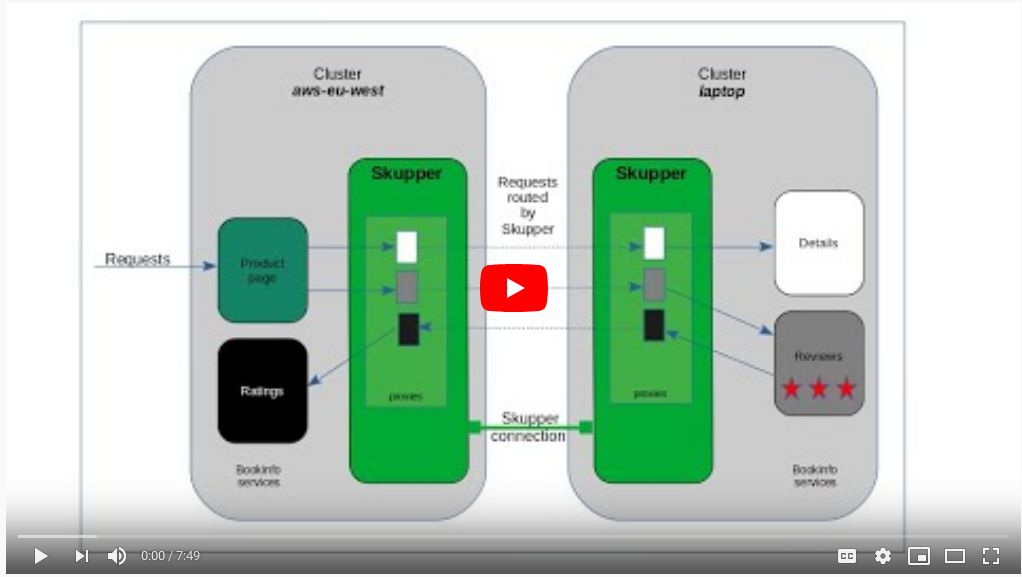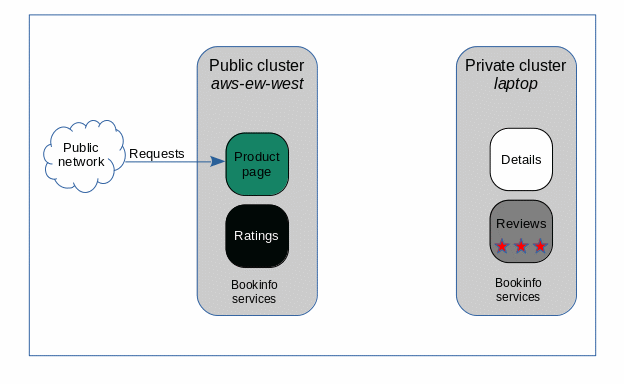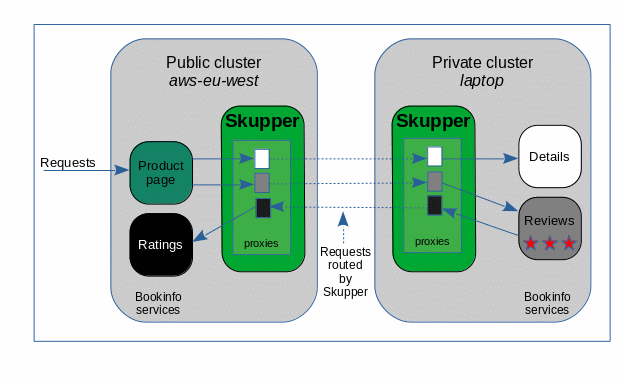This tutorial demonstrates how to distribute Istio Bookinfo Application microservices across multiple public and private clusters. The services require no coding changes to work in the distributed application environment. With Skupper the application behaves as if all the services are running in the same cluster.
This example further illustrates how services in a public cluster may access services in a private cluster when the private cluster will not accept incoming network connections and the private cluster has no ingress routes. Skupper infrastructure securely provides this connectivity and it does so without special user permissions, firewall rules, VPNs, sidecars, or system administrator actions.
In this tutorial you will deploy
the productpage and ratings services on a remote, public cluster
in namespace aws-eu-west
and
the details and reviews services in a local, on-premises cluster in namespace laptop.
Watch a video demonstrating this tutorial:
- Overview
- Prerequisites
- Step 1: Deploy the Bookinfo application
- Step 2: Expose the public productpage service
- Step 3: Observe that the application does not work
- Step 4: Set up Skupper
- Step 5: Connect your Skupper installations
- Step 6: Virtualize the services you want shared
- Step 7: Observe that the application works
- Clean up
- Next steps
- Credits
Figure 1 shows how the services will be deployed.
-
Each cluster runs two of the application services.
-
An ingress route to the productpage service provides internet user access to the application.
If all the services were installed on the public cluster then the application would work as originally designed. However, since two of the services are on the laptop cluster the application fails. productpage can not send requests to details or to reviews.
This demo will show how Skupper can solve the connectivity problem presented by this arrangement of service deployments.
Figure 2 shows how the clusters appear after Skupper has been set up.
Skupper is a distributed system with installations running in one or more clusters or namespaces. Connected Skupper installations share information about what services each installation exposes. Each Skupper installation learns which services are exposed on every other installation. Skupper then runs proxy service endpoints in each namespace to properly route requests to or from every exposed service.
-
In the public namespace the details and reviews proxies intercept requests for their services and forward them to the Skupper network.
-
In the private namespace the details and reviews proxies receive requests from the Skupper network and send them to the related service.
-
In the private namespace the ratings proxy intercepts requests for its service and forwards them to the Skupper network.
-
In the public namespace the ratings proxy receives requests from the Skupper network and sends them to the related service.
To run this tutorial you will need:
- The
kubectlcommand-line tool, version 1.15 or later (installation guide) - The
skuppercommand-line tool, the latest version (installation guide) - The
occommand-line tool, if using OKD for your public cluster (installation guide) - Two Kubernetes namespaces, from any providers you choose, on any clusters you choose
- The yaml files from https://github.com/skupperproject/skupper-example-bookinfo.git
- Two logged-in console terminals, one for each cluster or namespace
- If you are using
minikubeas your public cluster, run$ minikube tunnelin a separate terminal
This step creates a service and a deployment for each of the four Bookinfo microservices.
Namespace aws-eu-west:
$ kubectl apply -f public-cloud.yaml
service/productpage created
deployment.extensions/productpage-v1 created
service/ratings created
deployment.extensions/ratings-v1 created
Namespace laptop:
$ kubectl apply -f private-cloud.yaml
service/details created
deployment.extensions/details-v1 created
service/reviews created
deployment.extensions/reviews-v3 created
Namespace aws-eu-west:
$ kubectl expose deployment/productpage-v1 --port 9080 --type LoadBalancer
The Bookinfo application is accessed from the public internet through this ingress port to the productpage service.
If you are running your public cluster namespace aws-eu-west on OKD,
then you might need to create a route:
$ oc create route edge productpage --service=productpage
The web address for the Bookinfo application can be discovered from
namespace aws-eu-west:
$ echo $(kubectl get service/productpage -o jsonpath='http://{.status.loadBalancer.ingress[0].hostname}:9080')
If you are running a minikube cluster, then use:
$ echo $(kubectl get service/productpage -o jsonpath='http://{.status.loadBalancer.ingress[0].ip}:9080')
If you are running an OKD cluster, then use:
$ echo $(oc get route/productpage -o jsonpath='https://{.status.ingress[0].host}')
Open the address in a web browser. Productpage responds but the page will show errors because the
services in namespace laptop are not reachable.
Let's fix that now.
This step initializes the Skupper environment on each cluster.
Namespace laptop:
$ skupper init
Namespace aws-eu-west:
$ skupper init
Now the Skupper infrastructure is running.
Use skupper status in each console terminal to see that Skupper is
available.
$ skupper status
Skupper is enabled for namespace '"<ns>" in interior mode'. It is not connected to any other sites. It has no exposed services.
As you move through the steps that follow, you can use skupper status at any time to check your progress.
Now you need to connect your namespaces with a Skupper connection. This is a two step process.
-
The
skupper token create <file>command directs Skupper to generate a secret token file with certificates that grant permission to other Skupper instances to connect to this Skupper's network.Note: Protect this file as you would any file that holds login credentials.
-
The
skupper link create <file>command directs Skupper to connect to another Skupper's network. This step completes the Skupper connection.
Note that in this arrangement the Skupper instances join to form peer networks.
Typically the Skupper opening the network port will be on the public cluster.
A cluster running on laptop may not even have an address that is reachable from
the internet. After the connection is made the Skupper network members are peers
and it does not matter which Skupper opened the network port and which connected to it.
The console terminals in this demo are run by the same user on the same host.
This makes the token file in the ${HOME} directory available to both terminals.
If your terminals are on different machines then you may need to
use scp or a similar tool to transfer the token file to the system
hosting the laptop terminal.
Namespace aws-eu-west:
$ skupper token create ${HOME}/PVT-to-PUB-connection-token.yaml
Namespace laptop:
$ skupper link create ${HOME}/PVT-to-PUB-connection-token.yaml
Namespace aws-eu-west:
$ skupper status
Skupper is enabled for namespace '"aws-eu-west" in interior mode'. It is connected to 1 other site. It has no exposed service.
Namespace laptop:
$ skupper status
Skupper is enabled for namespace '"laptop" in interior mode'. It is connected to 1 other site. It has no exposed service.
You now have a Skupper network capable of multi-cluster communication
but no services are associated with it. This step uses the kubectl annotate
command to notify Skupper that a service is to be included in the Skupper network.
Skupper uses the annotation as the indication that a service must be virtualized. The service that receives the annotation is the physical target for network requests and the proxies that Skupper deploys in the other namespaces are the virtual targets for network requests. The Skupper infrastructure then routes requests between the virtual services and the target service.
Namespace aws-eu-west:
$ kubectl annotate service ratings skupper.io/proxy=http
service/ratings annotated
Namespace laptop:
$ kubectl annotate service details skupper.io/proxy=http
service/details annotated
$ kubectl annotate service reviews skupper.io/proxy=http
service/reviews annotated
Alternatively, Skupper command expose can be used as well:
Namespace aws-eu-west:
$ skupper expose service ratings --address ratings --protocol http
service ratings exposed as ratings
Namespace laptop:
$ skupper expose service details --address details --protocol http
service details exposed as details
$ skupper expose service reviews --address reviews --protocol http
service reviews exposed as reviews
Skupper is now making the annotated services available to every namespace in the Skupper network. The Bookinfo application will work because the productpage service on the public cluster has access to the details and reviews services on the private cluster and because the reviews service on the private cluster has access to the ratings service on the public cluster.
The web address for the Bookinfo app can be discovered from
namespace aws-eu-west:
$ echo $(kubectl get service/productpage -o jsonpath='http://{.status.loadBalancer.ingress[0].hostname}:9080')
If you are running a minikube cluster, then use:
$ echo $(kubectl get service/productpage -o jsonpath='http://{.status.loadBalancer.ingress[0].ip}:9080')
If you are running an OKD cluster, then use:
$ echo $(oc get route/productpage -o jsonpath='https://{.status.ingress[0].host}')
Open the address in a web browser. The application now works with no errors.
Skupper and the Bookinfo services may be removed from the clusters.
Namespace aws-eu-west:
skupper delete
kubectl delete -f public-cloud.yaml
Namespace laptop:
skupper delete
kubectl delete -f private-cloud.yaml
This demo uses public Bookinfo images provided by docker.io/maistra.


